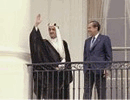 Irrigated Agriculture, Saudi Arabia March 1994 During the last two decades, the Saudi Arabia Government has invested in making the country self-sufficient in food production. As a result, widespread drilling for water increased, producing crop surpluses. This low-oblique, panoramic photograph shows a large area northwest of the capital of Riyadh, where the Saudis have converted nonvegetated desert land into thousands of circular, center-pivot-irrigated, cultivated fields. These irrigated fields vary in size from hundreds of yards (hundreds of meters) to more than a mile (2 kilometers) in diameter. This photograph shows a gradual arc that extends in a swath from south-southwest of Riyadh to the An Nafud (red desert) in northwest Saudi Arabia where center-pivot irrigation has transformed the desert into productive farmland. This drilling activity has been extremely costly, and the underground water supply (fossil water) is proving to be a one-time-only, nonrenewable resource. In the short term, the country has benefited by increasing its food production for internal consumption; however, because of a finite subsurface water supply, some scientific forecasters predict that in the near future the Saudi Arabian desert agriculture may revert to the original, nonvegetated desert environment.
Irrigated Agriculture, Saudi Arabia March 1994 During the last two decades, the Saudi Arabia Government has invested in making the country self-sufficient in food production. As a result, widespread drilling for water increased, producing crop surpluses. This low-oblique, panoramic photograph shows a large area northwest of the capital of Riyadh, where the Saudis have converted nonvegetated desert land into thousands of circular, center-pivot-irrigated, cultivated fields. These irrigated fields vary in size from hundreds of yards (hundreds of meters) to more than a mile (2 kilometers) in diameter. This photograph shows a gradual arc that extends in a swath from south-southwest of Riyadh to the An Nafud (red desert) in northwest Saudi Arabia where center-pivot irrigation has transformed the desert into productive farmland. This drilling activity has been extremely costly, and the underground water supply (fossil water) is proving to be a one-time-only, nonrenewable resource. In the short term, the country has benefited by increasing its food production for internal consumption; however, because of a finite subsurface water supply, some scientific forecasters predict that in the near future the Saudi Arabian desert agriculture may revert to the original, nonvegetated desert environment.



